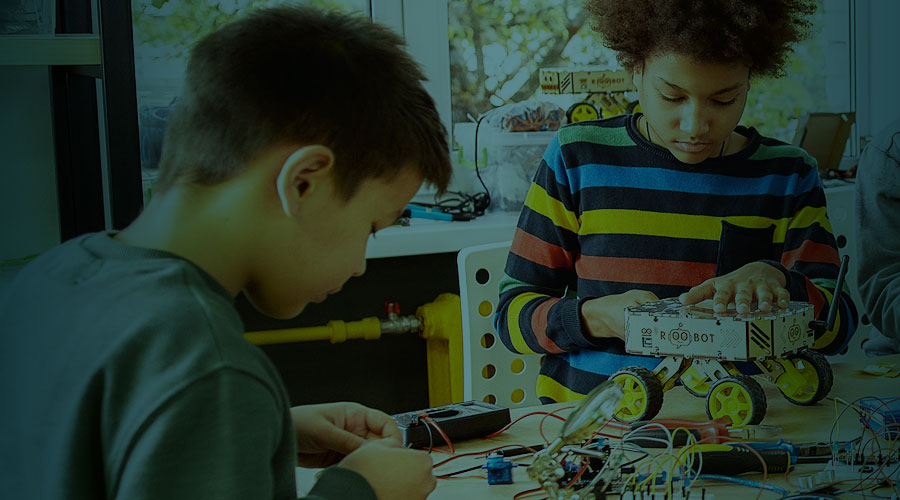It’s time to get applications prepped for children’s summer camp and classes. Do you have your research ready? It may still be winter, but kids who want to take summer classes or go to specialized camps typically must plan far ahead and get applications in, usually just after the start of the year. There are lots of STEM programs open to students who are typically underrepresented in the field, many of them free, but they do require applications and can be competitive to get into.
It’s this very process and this type of inside knowledge that can hold back students with racial, economic and social challenges. But there are programs and classes out there trying to reach talented eager students of color who are ready to tackle the creative challenges STEM learning encompasses. Many of these programs include coding tasks such as programming a robot to dance or creating a design for a 3D printer. Or involve figuring out the mathematics or aerophysics needed to launch their own rocket.
Free STEM Themed Camps and Programs Targeting Diversity
Here are a few of the free STEM camp programs specifically available to U.S. students underrepresented in college majors and careers in science, technology, engineering and mathematics.
SEEK is a free summer camp developed by the National Society of Black Engineers (NSBE) specifically for underrepresented students who might not otherwise have access to STEM learning in school. There are around 600 NSBE chapters in the U.S., so there could be a participating camp near you. The 3-week program is geared to students in 3rd through 5th grades. Students learn the principles of engineering and design and get to build a glider, a catapult and more.
Eureka!, by Girls Inc. of the Pacific Northwest, is a free 5-year program for girls that begins with a 4-week summer camp STEM immersion at a local community college and ends with internship experiences. Mentoring and support are part of the program which aims to create pathways for girls to major in science, engineering and technology at college and graduate with advanced degrees into careers.
Massachusetts Institute of Technology’s MITES is an intense free 6-week program open to rising high school seniors with strong academic skills and a desire to pursue careers in science and engineering. Students take math courses and load up on biology, chemistry and physics, along with electives to choose from like architecture and genomics.
Resources for K-12 Summer STEM Programs
There are many K-12 Summer STEM programs and classes if you know where to look. Most of these programs appear to be costly, but there may be scholarship funds available. It always pays to ask about tuition assistance or scholarships. Send an email, especially if you are contacting the program well in advance of the application deadline.
- The Institute for Broadening Participation (IBP) curates a list of fully-funded programs for K-8 and high school students. IBP’s mission is to increase diversity in the STEM workforce and provides access to opportunities and scholarships for underserved college age students as well.
- New Vision for Summer School Network, is being developed by the nonprofit National Summer Learning Association (NSLA). While it’s not focused solely on STEM, this 50- school district network across the country is trying to prevent students from slipping through the cracks by “increasing access to high-quality summer learning opportunities.” The site also has resources for proactive parents and educators.
- 50 Best Pre-College Summer Technology Programs for High School Students is a list by Bestcollegereviews.org that doesn’t strictly target diversity, but it’s fairly comprehensive. Drawbacks include the fact that many of these programs are state specific and most have a price tag.
A reminder, too, to check your neighborhood for programs. While not everyone lives close by public resources like a local library, they are still excellent places to connect with free learning opportunities school districts might not be able to provide. Local librarians might also be able to connect students to area educational resources and programs that don’t make national lists, but are every bit as challenging and dynamic.
Why Diversity-Centered Summer STEM Programs Work
Business leader Robert F. Smith, before he went on to Cornell University to earn a degree in chemical engineering, he participated in a summer program for minority students at the school. Smith spoke about the experience of coming to Ithaca, NY, while in high school during a 2016 talk at the university.
“[…] it was a revelation,” Smith said, describing the inclusive environment he found at Cornell. It was a place where his skills in math and science would be rigorously exercised; his creativity nourished; and where ultimately he found a space big enough to allow him to dream.
Being in a positive learning environment with peers and teachers who reflect what students see in their neighbors, homes or in their mirrors can have a profound impact.
The Cornell program, which Smith said he hoped would inspire minority students into the future, is now called Cornell’s Catalyst Academy. The program introduces high school students, especially “underrepresented minorities and women, to explore their burgeoning interest in engineering.”
Read more about STEM internships and opportunities for the summer, and beyond:






